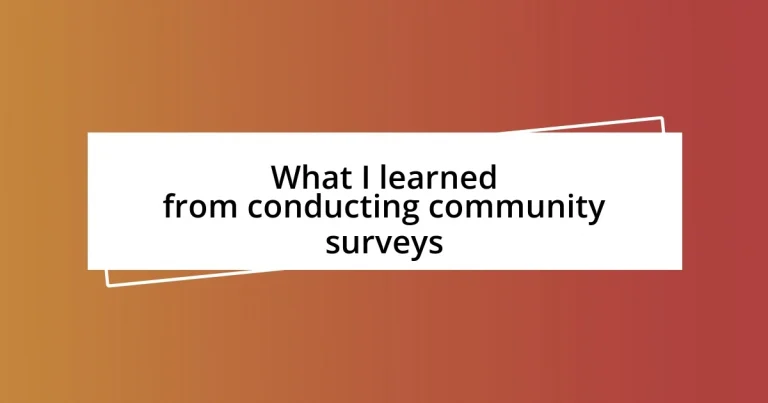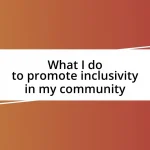Key takeaways:
- Community surveys are crucial for collecting data that reflects residents’ needs, fostering engagement and ownership among community members.
- Effective survey design requires clarity, neutrality, and a mix of question types, ensuring genuine responses and targeted feedback.
- Engagement methods and transparent communication of results build trust, encourage participation, and lead to meaningful change based on community feedback.
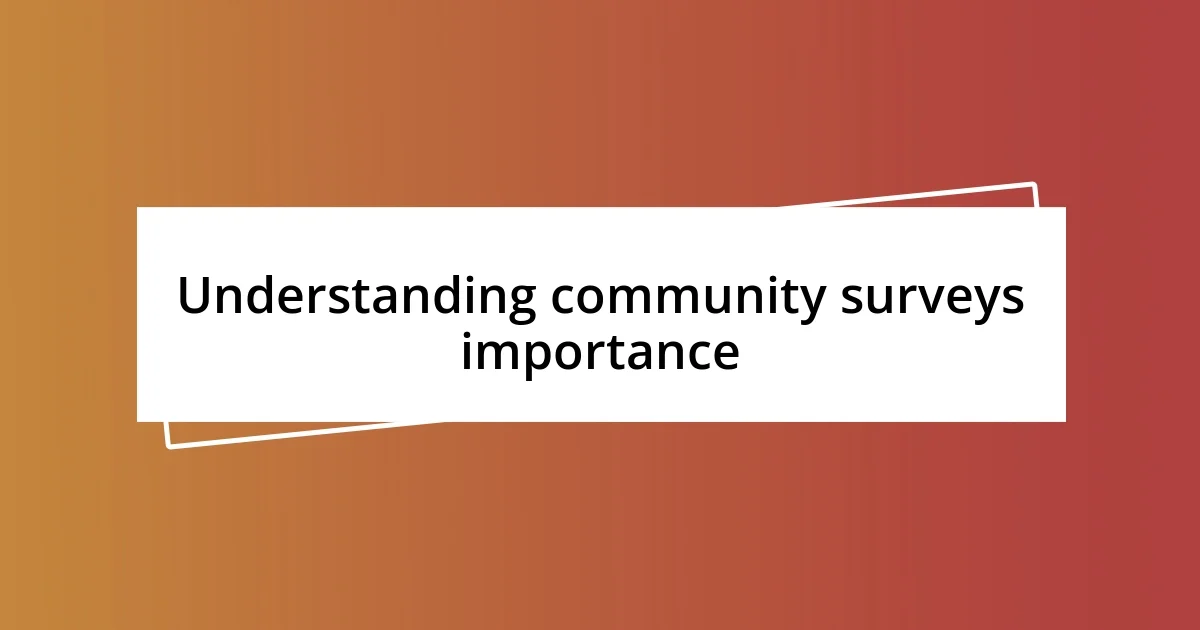
Understanding community surveys importance
Community surveys are vital tools for collecting impactful data that truly reflects the needs and preferences of residents. I remember conducting a survey in my neighborhood; it was eye-opening to see how diverse opinions could highlight areas that needed improvement. How can we truly understand our community’s pulse without hearing its voice?
The importance of community surveys extends beyond mere data collection; they foster engagement and ownership among residents. I’ve seen firsthand how involving people in the feedback process creates a sense of pride. When community members feel their insights matter, it nurtures a collaborative spirit that can lead to meaningful change.
Moreover, surveys provide a structured method for addressing specific issues. For instance, when my local park faced budget cuts, a survey revealed overwhelming support for its revitalization. Isn’t it empowering to realize that a simple questionnaire can steer decisions that shape our local environment? This direct line to decision-makers reinforces the notion that every voice counts.
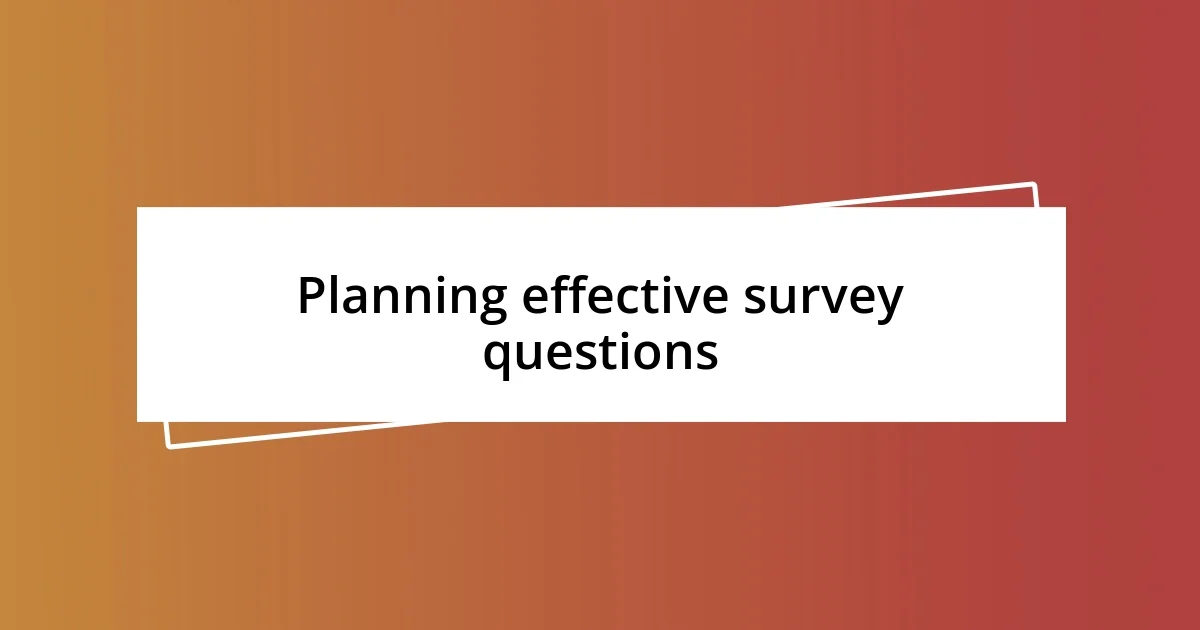
Planning effective survey questions
When planning effective survey questions, clarity is essential. During a project I worked on, I learned that I had to avoid jargon and overly complicated phrasing. This ensured that participants could understand what I was asking without confusion. I remember one question that was phrased too academically, and I received several comments that completely missed the point. It reminded me how important simplicity is in getting genuine responses.
To craft impactful survey questions, consider these key elements:
- Be specific: Narrow down what you want to ask to receive targeted feedback.
- Use neutral language: Avoid leading questions that suggest a particular answer.
- Keep it concise: Short questions often lead to higher response rates.
- Include a mix of question types: Use both closed (multiple choice) and open-ended questions to get a diverse range of insights.
- Pilot your questions: Testing the survey with a small group can highlight any confusing areas before wider distribution.
By applying these principles, you can foster a more engaging dialogue with your community, ensuring their voices are heard and valued.
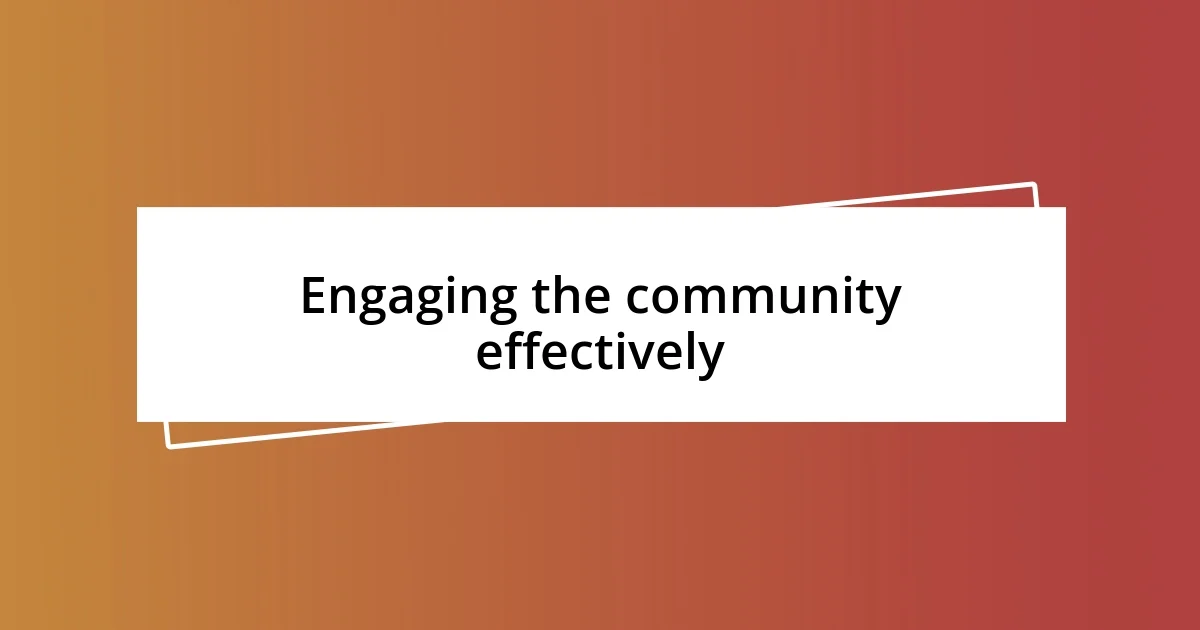
Engaging the community effectively
Engaging the community effectively requires genuine connection. I recall a community meeting where residents voiced their concerns, and I felt the collective frustration in the room. To capture that energy in surveys, I learned that personalizing outreach can make a huge difference. When people perceive that their contributions will genuinely influence decisions, they become more invested in the process.
Moreover, I found that using various engagement methods—like social media, newsletters, and in-person events—can significantly broaden participation. For instance, I once shared a survey link during a local festival, and the response was incredible. The excitement of face-to-face interactions made people more willing to take part, transforming a simple online survey into a lively discussion topic among neighbors.
Lastly, feedback loops are integral to keeping the community engaged. After completing my surveys, I made it a point to share the results and the subsequent actions taken. This transparency fosters trust and demonstrates that I value their contributions. Have you ever noticed that when people see their feedback in action, they are more likely to speak up in future surveys? It’s a powerful cycle of engagement that strengthens community ties.
| Engagement Method | Pros |
|---|---|
| In-person Meetings | Builds trust and fosters direct dialogue |
| Online Surveys | Wider reach and convenience for participants |
| Social Media Outreach | Engages younger demographics and encourages sharing |
| Community Events | Creates a fun atmosphere, encouraging participation |
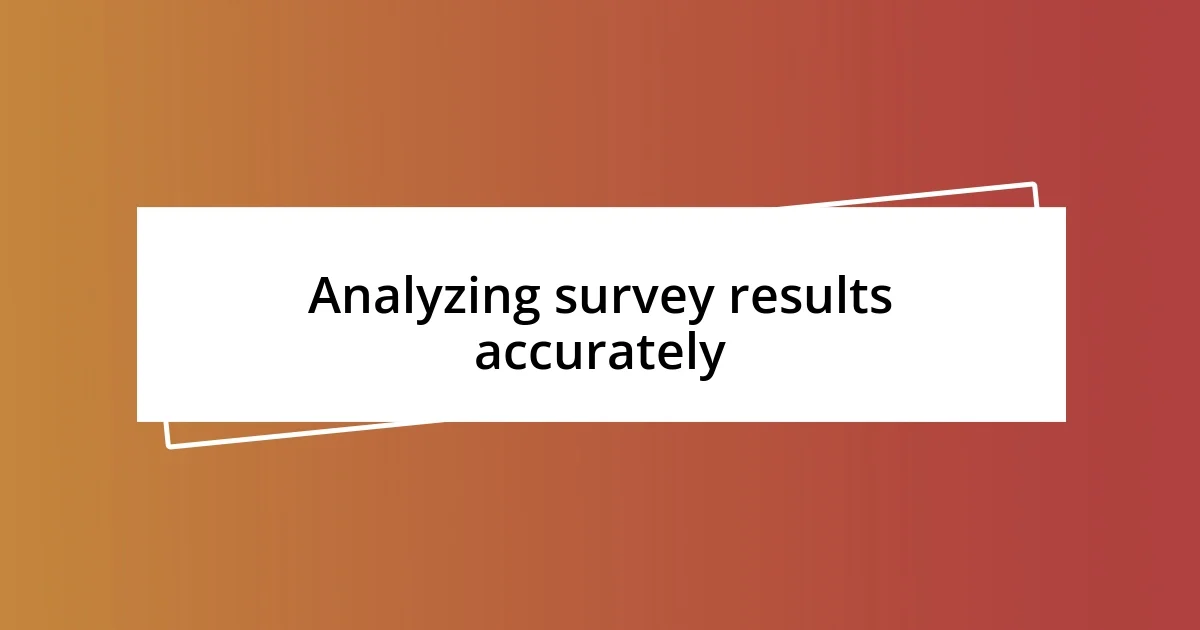
Analyzing survey results accurately
When it comes to analyzing survey results accurately, I quickly learned that data interpretation is just as important as data collection. One time, I was surprised to find that what I thought were clear trends in the feedback were actually skewed due to a small but vocal minority. This experience taught me to always look beyond the surface and consider the context of the responses. Have you ever jumped to conclusions based solely on first impressions? I know I have, and it leads to missing critical insights.
I’ve found that segmenting data can reveal patterns that a generalized overview might overlook. For instance, in one survey, I separated responses by age and found stark differences in opinions about community events. This was eye-opening! It reinforced the notion that understanding your audience is key; not every demographic will respond the same way. The richness of diverse perspectives can guide future initiatives and ensure everyone feels represented.
Finally, I realized the power of visualization when sharing results with stakeholders. I once created a simple infographic to highlight crucial data points, which sparked a vibrant discussion. Visual representations not only make complex information digestible but also foster engagement among those who may not be data-savvy. How do you prefer receiving information? I’ve noticed that a well-crafted visual can often tell a story that raw numbers simply can’t convey.
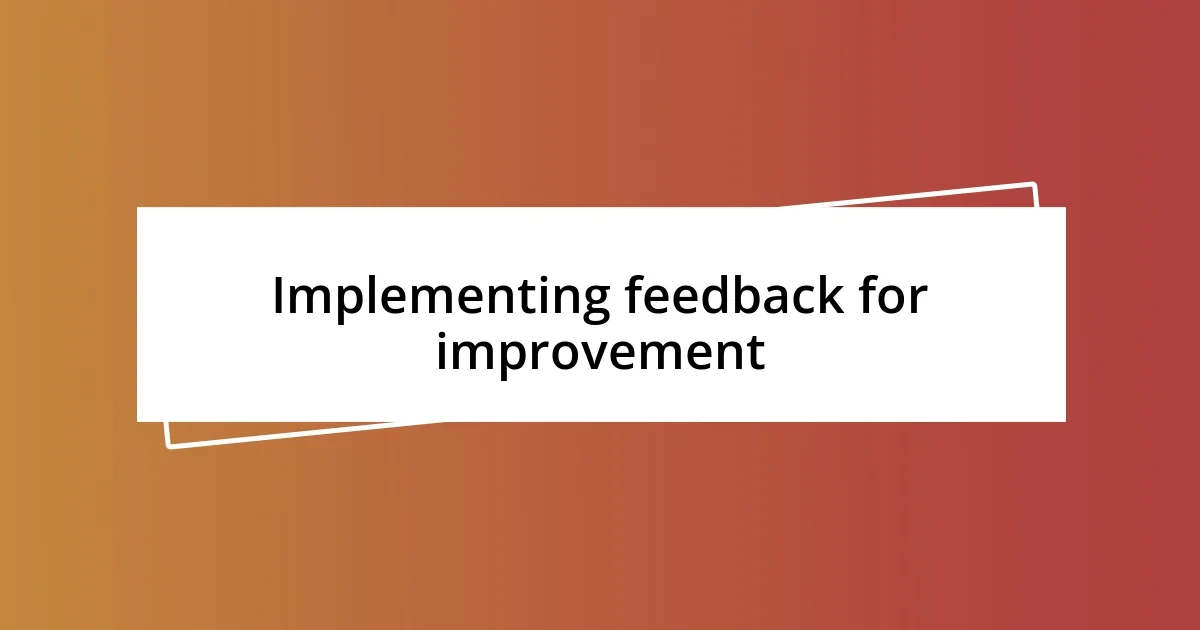
Implementing feedback for improvement
Implementing feedback for improvement is more than just a checkbox on a list; it’s about creating meaningful change based on what the community has expressed. I remember when we received mixed reviews about the frequency of local events. Instead of brushing off the negative feedback, I convened a small group of residents to explore their concerns. Engaging in this dialogue not only clarified many issues but also revealed deeper insights that weren’t evident in the survey results.
In another instance, after gathering feedback about local park facilities, we acted quickly to address the most pressing concerns. We prioritized fixing play equipment and enhancing park safety, then shared updates through community boards and social media. I was surprised to see how these relatively small actions led to a noticeable increase in community satisfaction. This experience reinforced my belief that timely implementation of feedback fosters a sense of ownership among residents—making them feel like they are part of the solution. Have you noticed how people begin to rally around initiatives when they see improvements happen?
I’ve also learned that celebrating improvements is essential. After we made changes based on feedback, I organized a small community gathering to showcase them. The smiles on people’s faces were contagious, and it ignited a buzz of excitement among attendees. It felt rewarding to see how acknowledging their input—and then showing how it transformed into action—made residents more engaged. Creating a culture where feedback is not only welcomed but also acted upon encourages an ongoing dialogue. Isn’t it fascinating how involvement fuels further participation?
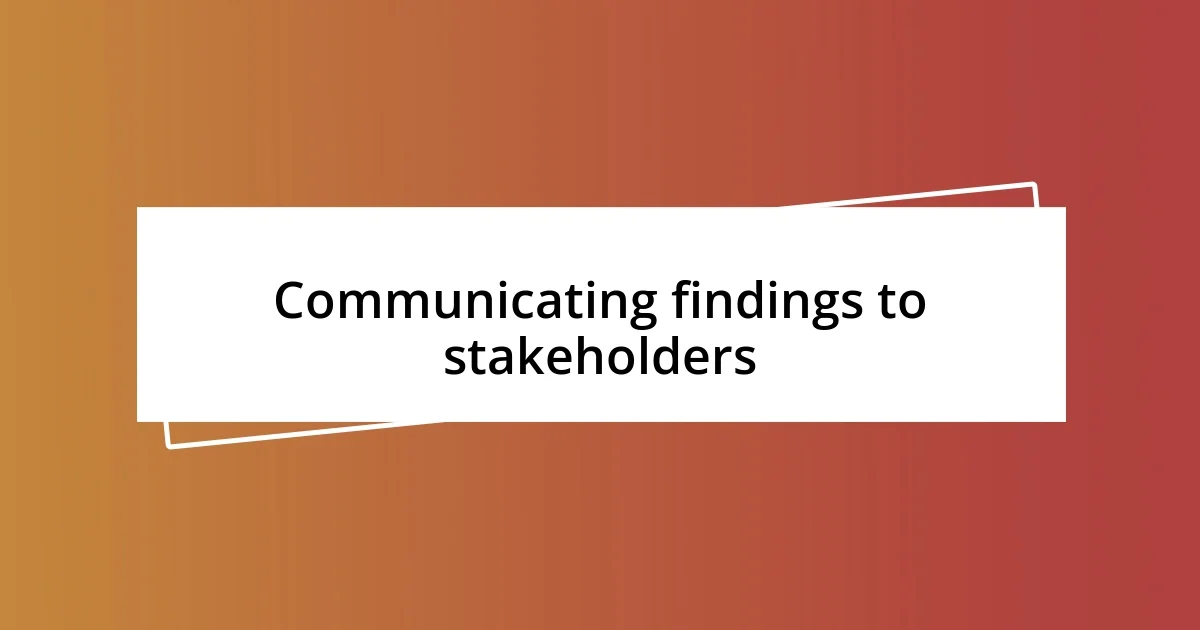
Communicating findings to stakeholders
Communicating findings to stakeholders is a delicate art that requires clarity and empathy. I recall a time when I presented survey results to a local council. I made a point to highlight both the positive feedback and the areas needing improvement, ensuring that everyone felt included and heard. Have you ever seen how differing perspectives in a room can shift the atmosphere? It’s fascinating how transparency can pave the way for constructive conversations.
When it comes to sharing data, I’ve learned the importance of framing the narrative effectively. Instead of merely presenting numbers, I crafted a story around the findings, showcasing real voices from the community. For instance, I shared quotes from residents that illustrated their experiences, making the data relatable. This approach not only engaged stakeholders but also fostered a deeper connection to the data. Have you ever found that storytelling can turn cold statistics into a powerful message? I find it captivating how a well-told story can resonate on a personal level.
Following presentations, I often invite questions and discussions. I remember one stakeholder who had concerns about the survey’s methodology. By addressing their questions openly and providing context, I strengthened trust and encouraged a collaborative atmosphere. It’s essential to create space for dialogue, as this makes stakeholders feel valued and involved in the process. How do you engage with your stakeholders after sharing results? Personally, I’ve found that such interactions often lead to fruitful brainstorming sessions that can shape better community initiatives down the line.

Enhancing future survey strategies
Enhancing future survey strategies begins with understanding the evolving needs of the community. For instance, during a recent project, I noticed that online surveys weren’t reaching everyone. Recognizing this gap, we shifted to a hybrid approach, incorporating in-person interviews, which not only increased participation but also enriched the quality of feedback. Have you ever considered how different formats can impact response rates and the depth of insights? I was amazed at how diverse engagement methods truly transformed our data collection process.
Additionally, I believe it’s crucial to involve the community in the survey design itself. In one instance, I held a brainstorming session with residents where they could voice what questions mattered most to them. This collaborative effort led to more relevant and targeted inquiries—questions that truly captured the community’s pulse. It was enlightening to see how their direct input made the survey feel more personal, and the result was a significant rise in thoughtful responses. Isn’t it interesting how that sense of ownership can foster deeper connections with the survey process?
Finally, I find leveraging technology can significantly streamline and enhance survey strategies. After experimenting with various platforms, I discovered that utilizing mobile-friendly surveys increased accessibility and convenience for participants. It was gratifying to hear positive feedback from those who appreciated the ease of responding on their devices. Have you explored how technology can break down barriers to participation? I think it’s vital to continuously evolve our strategies, utilizing insights from past experiences to refine our approaches for the future.












